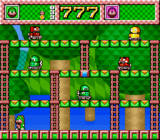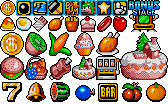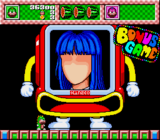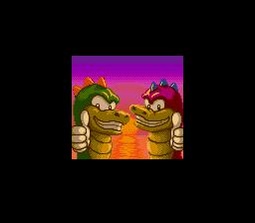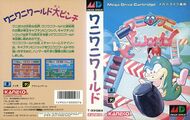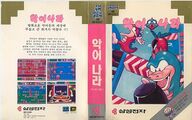Wani Wani World
From Sega Retro
- For the Game Gear version, see Berlin no Kabe.
| Wani Wani World | ||||||||||||||||||||
|---|---|---|---|---|---|---|---|---|---|---|---|---|---|---|---|---|---|---|---|---|
| System(s): Sega Mega Drive | ||||||||||||||||||||
| Publisher: Kaneko[1] | ||||||||||||||||||||
| Developer: Inter State[1] | ||||||||||||||||||||
| Supporting companies: T's Music (audio) | ||||||||||||||||||||
| Distributor: Samsung (KR) | ||||||||||||||||||||
| Sound driver: SMPS Z80 | ||||||||||||||||||||
| Genre: Action[2][3][4] | ||||||||||||||||||||
| Number of players: 1-2 | ||||||||||||||||||||
|
Wani Wani World (ワニワニWorld), known in South Korea as Ageo Nara (악어나라; Crocodile's Land), is a Sega Mega Drive puzzle action game developed by Inter State[1] and published by Kaneko.[1] It was first released in Japan in January 1992, and was brought to South Korea some time later.
It is a port of the publisher's 1991 arcade game The Berlin Wall (which was previously released for the Sega Game Gear under its Japanese title of Berlin no Kabe). The Mega Drive version features a substantially different art style and player characters. "Wani Wani World" means "Crocodile World."
Contents
Story
Wani Wani World (ワニワニワールド), a peaceful world containing only crocodiles, is in trouble. The evil Captain Pincock (キャプテンピンコック) has sent his underlings, the Four Heavenly Kings (四天王), to conquer the world. Charlie (チャーリ) and Smiley (スマイリー), two residents of Wani Wani World, must use their hammers to drive out the invaders.
Gameplay
The game is a single-screen platformer that plays nearly identically to Berlin no Kabe. Stages consist of ladders and platforms with monsters roaming around. Players control one of the crocodiles Charlie (player one) or Smiley (player two). Platforms (besides the floor at the bottom of the stage) consist of multiple segments that can individually be destroyed by the large mallets carried by the crocodiles, trapping any monsters that attempt to walk across. When a monster is trapped, it becomes harmless, and the crocodile can follow up by whipping the monster with his tail, causing the monster to fall through and explode into a bonus item. This also restores the hole into a solid platform. The crocodile only has a limited amount of time to do this before the monster works its way back out of the hole. Only one monster can be trapped in a single hole at a time. The explosion of the monster can destroy nearby enemies. Since the monsters move in predictable patterns, this can be exploited to destroy multiple monsters at a time, which awards larger bonuses. The goal is to trap and defeat all of the monsters to end the stage. The behavior of enemies varies depending on their color, with green enemies being the most placid and red enemies being the fastest and most aggressive. Some enemies can only be destroyed by explosions.
Each world consists of nine stages, followed by an autoscrolling stage where the crocodiles climb up or down to a boss fight, then a bonus round. There is a two-player mode where two players cooperate and play simultaneously, which can be started from the title screen or by pressing START on a second control pad during a game.
The crocodiles walk with ![]() and
and ![]() and climb ladders with
and climb ladders with ![]() and
and ![]() . They swing their hammers with
. They swing their hammers with ![]() , which cannot be used to attack enemies directly but can be used to break holes in platforms. If a monster falls into the hole, they can whip the monster with their tails with
, which cannot be used to attack enemies directly but can be used to break holes in platforms. If a monster falls into the hole, they can whip the monster with their tails with ![]() again. They can cover up holes when standing adjacent to it with
again. They can cover up holes when standing adjacent to it with ![]() . Some special items collected throughout the stages have effects that can be used with
. Some special items collected throughout the stages have effects that can be used with ![]() .
.
A crocodile loses a life if he touches a monster but revives if the player has extra lives remaining (losing any acquired item effects). The game ends if the player runs out of lives, but it can be continued if the player has credits remaining. The player can set the starting lives and credits in the options before starting the game. There are three difficulty levels (Easy, Normal, and Hard).
Platforms
| These platforms can be broken by a crocodile's hammer, leaving a hole that traps monsters that try to walk across. Monsters can then be whipped through to destroy them. It is also possible for a crocodile to fall through the hole. The hole persists for the rest of the stage unless covered up or restored by bashing a monster through it. The appearance varies by world. | |
| These platforms are indestructible and can always be walked across by crocodiles and monsters alike. The appearance varies by world. | |
| These platforms slow the crocodiles as they walk across them. They can be broken by a crocodile's hammer, leaving a hole that traps monsters, but monsters cannot be whipped through the hole and always climb out. The hole quickly recovers, restoring the platform. | |
| Springs launch the crocodiles into the air. Monsters will not walk across them. Since the crocodiles cannot jump, this is the only way for them to leap across gaps in the platforms. | |
| These platforms move up and down or left and right. | |
| Teleporters appear in pairs. Stepping on one teleporter warps the crocodile to the other one and vice versa. They are sometimes the only way to reach part of a stage. Monsters are not teleported when they step on these platforms. | |
| These platforms fall when a crocodile steps on them (with another one quickly taking its place). Crocodiles can run across them quickly without falling with them. Monsters will not step on these platforms, and monsters are unharmed if these platforms fall on them. | |
| These platforms fall when a crocodile moves under them (then slowly raise back up), potentially hitting the crocodile (but not affecting monsters). |
Items
These items are dropped by defeated monsters in stages.
Power-ups
Bonus points
The larger bonuses are awarded when multiple monsters are destroyed at the same time (by catching them in an explosion) or in the bonus game.
| Small Coin | |
|---|---|
| Awards 100 bonus points. | |
| Candy Bar | |
| Awards 100 bonus points. | |
| Apple | |
| Awards 200 bonus points. | |
| Fried Egg | |
| Awards 300 bonus points. | |
| Fries | |
| Awards 400 bonus points. | |
| Hot Dog | |
| Awards 500 bonus points. | |
| Dessert | |
| Awards 600 bonus points. | |
| Drumstick | |
| Awards 700 bonus points. | |
| Pudding | |
| Awards 800 bonus points. | |
| Large Coin | |
| Awards 900 bonus points. | |
| Cornstalk | |
| Awards 1,000 bonus points. | |
| Kiwifruit | |
| Awards 1,200 bonus points. | |
| Hamburger | |
| Awards 1,500 bonus points. | |
| Ice Cream | |
| Awards 2,000 bonus points. | |
| Small Cake | |
| Awards 3,000 bonus points. | |
| Meat | |
| Awards 3,500 bonus points. | |
| Fruit Basket | |
| Awards 5,000 bonus points. | |
| Roasted Chicken | |
| Awards 7,000 bonus points. | |
| Large Cake | |
| Awards 10,000 bonus points. | |
| Bonus Spin | |
| Spins the slot machine at the top of the screen, which causes bonus point items to drop from the ceiling if a winning combination is spun. |
Stages
- Main article: Wani Wani World/Maps.
Bonus game
After defeating the boss of each world, players play a bonus game in which they try to assemble a woman's face by stopping the pieces like a slot machine with ![]() : the head and hair, the eyes, the nose, then the mouth. Bonus point items are dropped after completing the face.
: the head and hair, the eyes, the nose, then the mouth. Bonus point items are dropped after completing the face.
History
Development
Early builds of the game retain the name and look of the arcade original, and at one point the game was slated for release in Japan as Berlin no Kabe in June 1991.[7] It was also scheduled to be brought to the United States (presumably by Kaneko USA) under the name The Berlin Wall in Winter 1991.[8] This localized version was only mentioned once in the February 1991 issue of New Game Release Information,[8] and is suspected to have been cancelled for a Japanese-only release.
Production credits
- Program: K.Shimizu, Rai
- Graphic Design: Dogurou, M.Kohu
- Map Design: Dogurou
- Title Design: Yokochin, Dogurou
- BG Design: Yokochin, Dogurou, M.Kohu
- Sound Compose: T's Music
- Special Thanks: Mr. Hamada, Hitomi Ohhasi, and You...
- Presented by: Inter State
Digital manuals
Magazine articles
- Main article: Wani Wani World/Magazine articles.
Promotional material
Physical scans
| Sega Retro Average | |||||||||||||||||||||||||||||||||||||||||||||||||||||||||||||||||||||||||||||||
|---|---|---|---|---|---|---|---|---|---|---|---|---|---|---|---|---|---|---|---|---|---|---|---|---|---|---|---|---|---|---|---|---|---|---|---|---|---|---|---|---|---|---|---|---|---|---|---|---|---|---|---|---|---|---|---|---|---|---|---|---|---|---|---|---|---|---|---|---|---|---|---|---|---|---|---|---|---|---|---|
|
| 73 | |
|---|---|
| Based on 15 reviews | |
| Mega Drive, JP |
|---|
Technical information
- Main article: Wani Wani World/Technical information.
References
- ↑ 1.0 1.1 1.2 1.3 http://gdri.smspower.org/wiki/index.php/Inter_State
- ↑ File:WaniWaniWorld MD JP Box.jpg
- ↑ File:WaniWaniWorld MD KR Box.jpg
- ↑ 4.0 4.1 https://sega.jp/history/hard/megadrive/software_l.html (Wayback Machine: 2020-07-02 23:21)
- ↑ Beep! MegaDrive, "December 1991" (JP; 1991-11-08), page 24
- ↑ https://www.amusement-center.com/project/egg/game/?product_id=1284
- ↑ File:Megadrive Fan 1991-04.pdf, page 118
- ↑ 8.0 8.1 https://groups.google.com/g/rec.games.video/c/uVNk7djCad0 (Wayback Machine: 2024-12-08 10:23)
- ↑ File:Wani Wani World MD credits.pdf
- ↑ Beep! MegaDrive, "February 1992" (JP; 1992-01-08), page 36
- ↑ Consoles +, "Mars 1992" (FR; 1992-0x-xx), page 92
- ↑ Console XS, "June/July 1992" (UK; 1992-04-23), page 136
- ↑ Famitsu, "1992-02-07" (JP; 1992-01-24), page 39
- ↑ Games-X, "13th-19th February 1992" (UK; 1992-02-13), page 22
- ↑ Hippon Super, "February 1992" (JP; 1992-01-07), page 97
- ↑ Joypad, "Avril 1992" (FR; 1992-03-1x), page 80
- ↑ Joystick, "Mars 1992" (FR; 1992-0x-xx), page 152
- ↑ Sega Mega Drive Advanced Gaming, "October 1992" (UK; 1992-xx-xx), page 79
- ↑ Sega Mega Drive Advanced Gaming, "January 1993" (UK; 199x-xx-xx), page 95
- ↑ MegaTech, "April 1992" (UK; 1992-03-20), page 42
- ↑ Play Time, "7/92" (DE; 1992-06-03), page 92
- ↑ Sega Pro, "March 1992" (UK; 1992-02-20), page 32
- ↑ Sega Pro, "April 1993" (UK; 1993-03-11), page 68
- ↑ Sega Saturn Magazine, "September 1995" (JP; 1995-08-08), page 87
| Wani Wani World | |
|---|---|
|
Main page | Maps | Hidden content | Magazine articles | Reception | Region coding | Technical information | Bootlegs | |

